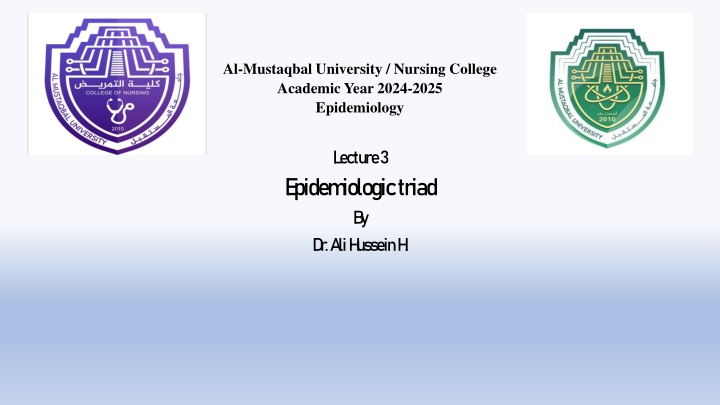
The Epidemiologic Triad in Public Health Nursing
Explore the epidemiologic triad in public health nursing, focusing on the interplay between host, agent, and environment. Learn about the factors influencing host susceptibility, different types of agents, and the role of the environment in disease transmission. Dive into the essential concepts and principles of epidemiology for a comprehensive understanding of health patterns and conditions.
Download Presentation

Please find below an Image/Link to download the presentation.
The content on the website is provided AS IS for your information and personal use only. It may not be sold, licensed, or shared on other websites without obtaining consent from the author. If you encounter any issues during the download, it is possible that the publisher has removed the file from their server.
You are allowed to download the files provided on this website for personal or commercial use, subject to the condition that they are used lawfully. All files are the property of their respective owners.
The content on the website is provided AS IS for your information and personal use only. It may not be sold, licensed, or shared on other websites without obtaining consent from the author.
E N D
Presentation Transcript
Al-Mustaqbal University / Nursing College Academic Year 2024-2025 Epidemiology L ecture 3 E pidem iologic triad B y D r. A li H ussein H .
E pidem iologic triad The science of epidemiology draws on certain basic concepts and principles to analyze and understand patterns of occurrence among aggregate health conditions.
E pidem iologic triad The epidemiology model promote understanding the relationship between Host Agent environment. The interrelationship of these elements results in a state of illness.
H ost The host susceptible human or animal who ports and nourish a disease-causing agent. Many physical psychological and lifestyle factors influence the host weakness and response to an agent.
Factors influence the host 1-Physical factor: include age, gender, and genetic factor influence on the host resistance. 2-Psychological factor: such as people outlook and response to stress, can be strongly influence on host exposure. 3-Life style factor: that play major role include diet, exercise, sleep pattern, healthy and unhealthy habits all contribute to decrease or increase weakness to the disease causing agent.
A gent Agent: is a factor that causes or contribute to health condition or problems. Causative agent can be present such as bacterial that cause tuberculosis or lacking of iron in the body that cause anemia.
Types of A gents Agents can be classified into six types: 1-Biological agent :that include bacterial, viral, fungi, protozoa, worms and insects. 2-Chemial agent: may in the form of liquid, soils, gases, dusts. 3-Nutreint agent: include essential dietary components which if deficiency or taken in excess can product illness. 4-Physical agent: include anything mechanical, material, radiation that causes injury to human. 5-Psychological agent : are events producing stress that lead to health problems. 6. Genetic agents :arise from genetic transmission from parent to child
Environment Environment: The environment refers to all external factors surrounding the host that might influence vulnerability or resistance. 1-physical environment: include factors like geography, climate ,weather, safety building. 2-psychological environment: refer to culture social and economic and psychological influence and condition that effect health.
C hain of C ausation The chain begins by Reservoir: Any human beings, animals, plants in which an infectious agent normally lives and multiplies and from which it passes to a new host. EX; plague, that reservoir may be other humans, rats,, and a few other animals. malaria, infected humans are the major reservoir for the parasitic
C hain of C ausation Next, the agent must have a portal of exit from the reservoir, as well as some mode of transmission. For example, the bite of an Anopheles mosquito provides a portal of exit for the malaria parasites Mosquito in this case is the mode of transmission.
C hain of C ausation The next link in the chain of causation is the agent itself. The next link is the portal of entry. In the case of malaria, the mosquito bite provides a portal of exit as well as a portal of entry into the human host.
Mode of transmission: Mode of transmission: The way disease agents are transmitted from the source of infection to new hosts by the following : 1. Droplet contact route coughing or sneezing on another individual 2. Direct physical contact route 3. Indirect physical contact route: touching a contaminated surface, including soil 4. Airborne route 5. Fecal-oral route 6. Transmission by insect or animal bite
Communicable diseases classification in epidemiology: 1)Endemic: when an infectious agent or disease has a constant presence within a defined geographic area. 2) Epidemic: occurrences of infectious agent or disease that clearly exceed the usual expected frequency of the disease in a particular population. 3) Pandemic: when an epidemic outbreak occurs worldwide.
HAVE A NICE DAY Thank you 19.03.2025 16






















